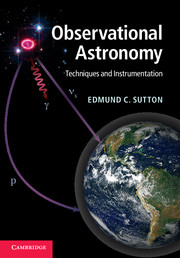Book contents
- Frontmatter
- Contents
- List of illustrations
- List of tables
- Preface
- Acknowledgements
- 1 Astrophysical information
- 2 Photometry
- 3 Positional astronomy
- 4 Fourier transforms
- 5 Detection systems
- 6 Orthodox statistics
- 7 Stochastic processes and noise
- 8 Optics
- 9 Interference
- 10 Spectroscopy
- 11 Ultraviolet, x-ray, and gamma ray astronomy
- 12 Radio receivers, spectrometers, and interferometers
- 13 Modern statistical methods
- 14 Neutrino detectors
- 15 Cosmic ray detectors
- 16 Gravitational waves
- 17 Polarimetry
- Appendix A Physical constants and units
- Appendix B Acronyms
- Appendix C Additional reading
- References
- Index
- Plates
5 - Detection systems
Published online by Cambridge University Press: 05 June 2012
- Frontmatter
- Contents
- List of illustrations
- List of tables
- Preface
- Acknowledgements
- 1 Astrophysical information
- 2 Photometry
- 3 Positional astronomy
- 4 Fourier transforms
- 5 Detection systems
- 6 Orthodox statistics
- 7 Stochastic processes and noise
- 8 Optics
- 9 Interference
- 10 Spectroscopy
- 11 Ultraviolet, x-ray, and gamma ray astronomy
- 12 Radio receivers, spectrometers, and interferometers
- 13 Modern statistical methods
- 14 Neutrino detectors
- 15 Cosmic ray detectors
- 16 Gravitational waves
- 17 Polarimetry
- Appendix A Physical constants and units
- Appendix B Acronyms
- Appendix C Additional reading
- References
- Index
- Plates
Summary
Interaction of radiation and matter
In order to study electromagnetic radiation, it is necessary for the radiation to interact in some fashion with some physical “detector.” If we think of the radiation in terms of photons, there are three types of interactions available to us: the photoelectric effect, Compton scattering, and pair production. Variations on these effects form the basis of photon detectors. Electromagnetic radiation can also be thought of in terms of waves, and in some situations the wave picture is more appropriate for understanding the detection process. Wave detectors could either measure the electromagnetic field directly or measure the power transfer from electromagnetic energy into thermal energy. There is no strict dividing line between these views since electromagnetic radiation always retains both particle and wave characteristics. But roughly speaking, the particle viewpoint is more useful at high frequencies, where the photons are energetic, and the wave viewpoint is more useful at lower frequencies. One characteristic which helps determine which viewpoint may be more useful is 〈n〉, the average photon occupation number of the modes of the radiation field.
Photoelectric effect
For an isolated atom, there is a threshold energy for removing a bound electron, the ionization potential, which varies depending on what shell the electron occupies. The shells are designated K, L, M…, depending on the principal quantum number (n = 1, 2, 3, …). For hydrogen, the ionization potential from n = 1 corresponds to an ultraviolet photon (the Lyman limit at 91.2 nm or 13.6 eV).
- Type
- Chapter
- Information
- Observational AstronomyTechniques and Instrumentation, pp. 66 - 86Publisher: Cambridge University PressPrint publication year: 2011



